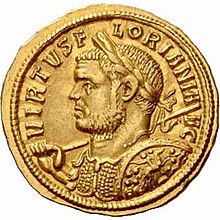Marcus Annius Florianus (died 276), also known as Florian, was Roman emperor from the death of his half-brother, Emperor Tacitus, in July 276 until his own murder in September of that year.
| Florianus | |||||||||
|---|---|---|---|---|---|---|---|---|---|
 | |||||||||
| Roman emperor | |||||||||
| Reign | c. July–September 276 | ||||||||
| Predecessor | Tacitus | ||||||||
| Successor | Probus | ||||||||
| Died | c. September 276[1] Tarsus, Cilicia | ||||||||
| |||||||||
Florianus was the maternal half-brother of Tacitus, who was proclaimed emperor in late 275 after the unexpected death of Emperor Aurelian. After Tacitus died the following year, allegedly assassinated as a consequence of a military plot, Florianus proclaimed himself emperor, with the recognition of the Roman Senate and much of the empire. However, the new emperor soon had to deal with the revolt of Probus, who rose up shortly after Florianus ascended the throne, with the backing of the provinces of Egypt, Syria, Palestine, and Phoenicia. Probus took advantage of the terrain of the Cilician Gates, and the hot climate of the area, to which Florianus' army was unaccustomed, to chip away at their morale. Florianus' army rose up against him and killed him.
History
editIn late 275, Florianus' maternal half-brother, Tacitus, was proclaimed Roman Emperor after the unexpected death of Emperor Aurelian. Soon after, Tacitus appointed Florianus as praetorian prefect.[3][4] Tacitus then ordered Florianus to lead troops to Pannonia, in order to repel raids into Roman territory by the Goths.[5] After Tacitus died suddenly in July 276, allegedly as a consequence of a military plot, Florianus swiftly proclaimed himself emperor, and was recognized as such by the Roman Senate and the western provinces.[6] Florianus then continued to campaign against the Goths, winning a major victory before the news reached him of the revolt of Probus, who had served successfully as a commander under both Aurelian and Tacitus. Probus' revolt was supported by the provinces of Egypt, Syria, Palestine, and Phoenicia.[6]
Probus took advantage of his control of Egyptian grain, which he used to swiftly cut off the supply of grain to the rest of the empire. He led his troops to Asia Minor, in order to defend the Cilician Gates, allowing him to utilize guerrilla tactics to wage a war of attrition rather than a straightforward confrontation. Florianus led his troops to Cilicia, and billeted his forces in Tarsus. However, many of his troops, who were unaccustomed to the hot climate of the area, fell ill due to a summer heat wave. Upon learning of this, Probus launched raids around the city, in order to weaken the morale of Florianus' forces. This strategy was successful, and Florianus lost control of his army, which rose up against him and killed him.[6] Florianus' reign lasted less than three months, 88 days according to the Chronograph of 354[7] and 80 days according to Eutropius.[8]
See also
editReferences
editCitations
edit- ^ Peachin, Michael (1990). Roman Imperial Titulature and Chronology, A.D. 235–284. Amsterdam: Gieben. pp. 46–47. ISBN 90-5063-034-0.
- ^ Cooley, Alison E. (2012). The Cambridge Manual of Latin Epigraphy. Cambridge University Press. p. 500. ISBN 978-0-521-84026-2.
- ^ Meijer 2004, p. 102.
- ^ Hebblewhite 2016, p. 11.
- ^ Bédoyère 2017, p. 259.
- ^ a b c Meijer 2004, p. 103.
- ^ Filocalus, Chronograph of 354, Part 16: "Florian ruled 88 days. He was killed at Tharsus."
- ^ Eutropius, 9:16[usurped]. "Florianus, who succeeded Tacitus, was on the throne only two months and twenty days, and did nothing worthy of mention.
Bibliography
edit- Bédoyère, Guy de la (2017). Praetorian: The Rise and Fall of Rome's Imperial Bodyguard. Yale University Press. ISBN 9780300226270.
- Hebblewhite, Mark (2016). The Emperor and the Army in the Later Roman Empire, AD 235–395. Taylor & Francis. ISBN 9781317034308.
- Meijer, Fik (2004). Emperors Don't Die in Bed. Routledge. ISBN 9780415312011.
- Syvanne, Ilkka (2015). Military History of Late Rome 284-361. Pen and Sword. ISBN 9781848848559.
External links
editMedia related to Florianus at Wikimedia Commons